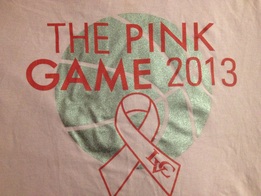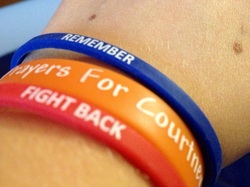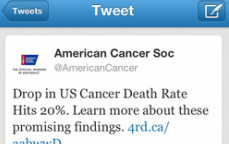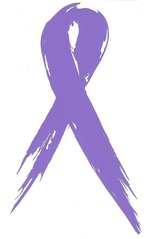 I always hated the color pink. My parents overwhelmed my wardrobe with shades of fuchsia, magenta, and coral— pink—and once I was old enough to recognize it, I decided I’d never wear it again. It didn’t matter how cute or cool the outfit was. I wasn’t wearing it if it was pink.
Now, pink has an entirely different meaning, and no, I’m not talking about the Victoria’s Secret clothing line. I remember during my sophomore year of high school I was given a pink ribbon to wear on my marching band uniform to support a classmate’s mom who had recently been diagnosed with breast cancer. That ribbon remains on my duffle bag today.
Pink is probably the first color that I ever associated with cancer (another reason to hate it). After all, breast cancer is the number one cancer faced by women in the United States with the exception of skin cancer. An estimated 227,000 American women were diagnosed with breast cancer in 2012 alone—one of them my close friend’s mom.
As I stood with other members of LVC’s Colleges Against Cancer organization in the Arnold Sports Complex last night I couldn’t help but smile. I stood amazed at the top of the stadium as I looked at the crowd of people normally sporting blue and white covered in shades of pink from head to toe. Women and men, children and adults, professors and other athletes gathered at the women’s basketball game to participate in LVC’s 6th annual Pink Game, which raises money and awareness for breast cancer. I stood because I couldn’t find an empty seat.
Cancer changes everything; even your favorite color. I’ll admit that I was also covered from head to toe in pink last night. From my shoes to my shirt designed specifically for the game, pink was the only way to describe my outfit and I was ecstatic.
There’s just something about being a part of an event like the Pink Game that can’t be explained. Being surrounded by people all there willing to help and donate any money they can is overwhelming. We were constantly thanked by attendants for our help in hosting the event but all we could reply was “No, thank you for coming.” While we put the event together it would have been nothing without participation from the students, staff, and community.
The funds and awareness raised by LVC’s Pink Game will not go unnoticed. Actually I’m happy to announce that yesterday, the same day that I saw our sports arena packed full of a community fighting back against cancer, my friend’s mom received her last breast cancer radiation treatment. We will make a difference by raising awareness—it takes time, effort, love, support, and a little color—Pink.
 On December 2, 2012 (exactly two months ago) I lost a high school classmate to cancer—leukemia to be exact. I remember precisely how I heard the news. It was a Sunday morning. I had managed to wake up, find my glasses that I had tossed off the night before, and was beginning to do my morning scan of the news (Facebook news that is). As I sat on my bed, still in sweats and hair a mess, I felt a knot in my stomach and my heart begin to race. Post after post revealed that something went wrong—something wasn’t right. “Prayers for Courtney” and “Stay strong” repeated over and over on my newsfeed as more old classmates heard the same news I was reading and tried to express their concern, support, and hope to our friend Courtney. A text message confirmed my biggest fear; the fight was over.
Courtney was diagnosed with AML, a cancer of the blood and bone marrow, on December 24, 2010, our senior year of high school. Following her diagnosis, she underwent four rounds of chemotherapy over the span of six months. During that time our community came together and decided not to let her face the fight alone.
Along with a group of about twenty other students of Waynesboro Area Senior High School, I helped to plan and host our first ever miniTHON, a fundraising event based off of Penn State’s THON which raises millions of dollars for pediatric cancer every year. The Art Club designed and sold t-shirts and bracelets to help raise funds and awareness of leukemia. This was the closest I can remember ever seeing our student body, and it was great.
BORO miniTHON was the second major fundraising event I had ever taken part in and probably the most influential in my desire to pursue a career in the non-profit world. While I was not close friends with Courtney during high school, it was a small school of 1,200 students and I knew exactly who she was and I learned so much more about her throughout her fight with cancer. Courtney truly was an inspiration to me. I followed her journey via Facebook and newspaper articles and could never get over the fact that every status she made or picture she posted was 100% positive. Still today, looking back, I remember her smile more than anything.
Perhaps my fondest memory of Courtney’s journey occurred on the night of our high school graduation. During our commencement we were told that in order to give every student their moment of recognition, applause was to be held until the end of the ceremony, and for the most part that happened. That is, until Courtney’s name was called. As she walked on to the stage I saw one of the most amazing moments of my life take place. The entire crowd of relatives, friends, administrators, teachers, and faculty were on their feet and the applause boomed throughout the gymnasium. It was recognition deserved by a hero—our hero.
Now, two months since Courtney’s battle ended I find it most important to look back and remember. Remember the closeness our community felt working together to help another. Remember the strength she had that allowed her to keep a smile on her face no matter what cancer threw at her. Remember the admiration felt in witnessing an everyday hero. Remember how lucky I was to know Courtney Sprenkle.
A reflection of the accomplishments made by the 2012 Colleges Against Cancer student-led organization at LVC.
 Good news! A recent tweet made by the American Cancer Society states that the cancer death rate in the United States has decreased by twenty percent, a result members of the American Cancer Society are ecstatic about. However, I do not think the statistic of 20% adequately describes how significant this accomplishment is for cancer patients in America. Twenty percent equals four hundred lives being saved from cancer every single day.
This year marks the 100th anniversary of the American Cancer Society which works to “save lives and create a world with less cancer and more birthdays.” Today, the organization has over a million supporters worldwide which all come together to help eliminate cancer as a major health problem. In order to do so they develop programs to help with cancer research, education, advocacy, and patient services programs.
Through events such as Relay For Life and Making Strides Against Breast Cancer the American Cancer Society raises billions of dollars every year. Even students here at LVC have the opportunity to join in the fight against cancer by joining Colleges Against Cancer, led by president Amanda Hanna a senior physical therapy major. The group of students which far exceeds any other student-led organization on campus with over 200 members meets at least once a month to discuss different events to help raise awareness of cancer on our campus. The group is in charge of Pink Week, Great American Smoke Out, Paint the Campus Purple, and Relay For Life.
The work of those involved in ACS organizations does make a difference. Here’s how:
· 1976 - The California Division of the American Cancer Society got nearly one million smokers to quit for the day, marking the first Great American Smokeout®, which became a nationwide event the next year.
· 1978 - Tamoxifen was approved by the PDA for treating estrogen receptor positive breast cancer. Society-funded Bernard Fisher, MD, Richard Love, MD, and V. Craig Jordan, PhD, developed and carried out the first trial of tamoxifen to prevent recurrence in breast cancer survivors
· 1980 - Early detection guidelines for breast cancer were developed.
· 1985 - The first American Cancer Society Relay For Life® was held in Tacoma, Washington. Today, the event is held in nearly 3,400 communities nationwide and raises more than one billion dollars for the Society's cancer research, education, advocacy, and patient services programs.
· 1989 - The Society teamed with the Personal Care Products Council (formerly the Cosmetic, Toiletry and Fragrance Association, or CFTA) to produce Look Good ... Feel Better®, a program which helps women deal with the appearance-related side effects of cancer treatment.
· 1991 - Society-funded research showed that young children recognize Joe Camel as easily as Mickey Mouse, demonstrating that the cartoon character reaches an audience well under the legal smoking age.
· 1998 - The five-year relative survival rate improved to 58%. (In 1960, it was 37% for men and 39% for women.) The FDA approved the use of Herceptin, a monoclonal antibody developed by former Society grantee Dennis Slamon, MD, for treatment of certain breast cancers.
· 2001 - The Society took the lead in successfully convincing Congress to enact new legislation to extend Medicare coverage of colonoscopy to average-risk individuals age 50 or older.
· 2002 - The Society launched a new 501 (c)4 sister organization—the American Cancer Society Cancer Action Network-to provide new opportunities for voter education and direct advocacy for cancer legislation.
· 2007 - An American Cancer Society report showed the first decline in actual number of cancer deaths in the more than 70 years since nationwide data began to be compiled.
· 2013- An American Cancer Society report showed a 20% decrease in the cancer death rate in the United States. 20% is equivalent to 400 lives being saved every day.
If anything, these accomplishments give us reason to hope. Sometimes cancer can push us deep inside ourselves and make us afraid to look toward the future; however, organizations like the American Cancer Society give us hope. They refuse to give up and relentlessly fight to eliminate cancer from our world and have more birthdays as a result. We, those affected by the horrible effects of cancer remain hopeful. We hope for more volunteers. We hope for more doctors and nurses. We hope for more medicine and treatments. We hope for fewer sick patients. We hope for a cure.
 Walk into a room full of people and try to find something you all have in common. I’m sure you would automatically resort to the typical icebreaker questions and begin comparing names, birth dates, hometowns, favorite sport teams and colors. Of course you’ll find a few people that coincidentally share some of your biographical information, but the chances of everyone in that space having an identical set of facts is slim to none. However, bring up the word “cancer” and I’m positive you will have found what you all share. Double, triple, multiply the amount of people in that room by any number and I know the result will be the same. We are all linked by one diagnosis, one disease, one word: cancer.
Cancer has many tests. On the medical side: doctors and scientists work countless hours to find a cure, relieve the pain, and prescribe adequate treatments. On the home front: how do you comfort someone when your world seems to have completely fallen apart? As the patient: you are challenged mentally, physically, and spiritually every day. But the likeliness of overcoming each test increases with perseverance, endurance, and hope.
While each story we could share would inevitably be different, they originate at the same place—with someone receiving the life-altering news “You have cancer.” Three words. So simple. But at the same time so complex. Whether you’re the patient, the doctor, a relative, a friend, or an acquaintance, relaying that news will never be an easy feat.
In 2012 alone, an estimated 1,638,910 new cases of cancer were predicted to be diagnosed in the United States and unfortunately 577,190 American cancer patients were expected to lose their fight against cancer last year. It is important to remember that these statistics are more than just numbers. Each data entry is a life: a mother, father, grandparent, sibling, spouse, best friend, classmate, neighbor, co-worker, the list goes on and on, but it needs to stop.
That’s where I come in. I am refusing to let these numbers continue to grow—to exist at all. I personally believe with enough support we can wipe out cancer. Through fundraising, educating, and simply caring for those affected, we can begin eliminating the horrible effects of cancer one person at a time.
|




 RSS Feed
RSS Feed